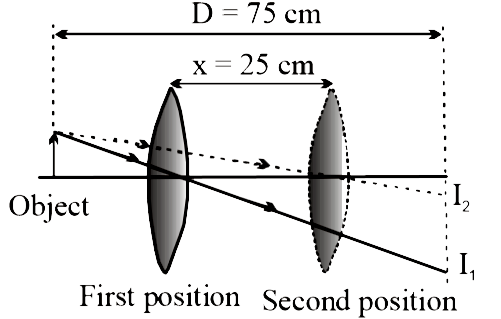The height of the image formed by acoverign lens on a screen is8cm,For the same position of the object and the screen again an Image of size12.5cmis formed on the screen by shifting the lens.The height of the object.
625/32cm
64/12.5cm
10cm
none
The correct Answer is:C
From displacement method
h=√h1h2⇒h=√8×1.25⇒h=10cm
Similar Questions
A thin converging lens is placed between an object and a screen whose position are fixed. There are two positions of the lens at which the sharp image of the object is formed on the screen. Find the transverse dimension of the object if at one position of the lens the image dimension equal h'=2.0mm and at the other, h''=4.5mm.
View SolutionTry this
Material: Convex lens, screen, metre scale, stand for the lens etc.
Method:
Keeping the screen fixed, obtain a clear image of a distant object like a tree or a building with the help of the lens on the screen. Measure the distance between the screen and the lens with the help of the metre scale. Now tum the other side of the lens towards the screen. Again obtain a clear image of the distant object on the screen by moving the lens forward or backward. Measure the distance between the screen and the lens again.
What ls this distance between the lens and the screen called?
View Solution
Knowledge Check
A convex lens forms a real image 16 mm long on a screen. If the lens is shifted to a new position without disturbing the object or the screen then again a real image of length 81 mm is formed. The length of the object must be
A48.5 mmB36 mmC6 mmD72 mmA convex lens forms an image of an object on a screen 30 cm from the lens. When the lens is moved 90 cm towards the object, then the image is again formed on the screen. Then, the focal length of the lens is
A13 cmB24 cmC33 cmD40 cmA convex lens makes a real image 4 cm long on a screen. When the lens is shifted to a new position without disturbing the object, we again get a real image on the screen which is 16 cm tall. The length of the object must be
A1/4cmB8cmC12cmD20cm
Try this
Material: Convex lens, screen, metre scale, stand for the lens etc.
Method:
Keeping the screen fixed, obtain a clear image of a distant object like a tree or a building with the help of the lens on the screen. Measure the distance between the screen and the lens with the help of the metre scale. Now tum the other side of the lens towards the screen. Again obtain a clear image of the distant object on the screen by moving the lens forward or backward. Measure the distance between the screen and the lens again.
What will happen if you use a concave lens in this experiment?
View SolutionTry this
Material: Convex lens, screen, metre scale, stand for the lens etc.
Method:
Keeping the screen fixed, obtain a clear image of a distant object like a tree or a building with the help of the lens on the screen. Measure the distance between the screen and the lens with the help of the metre scale. Now tum the other side of the lens towards the screen. Again obtain a clear image of the distant object on the screen by moving the lens forward or backward. Measure the distance between the screen and the lens again.
What ls this distance between the lens and the screen called?
View SolutionA convex lens when placed in the first position forms a real image of an object on a fixed screen. The distance between the object and the screen is 75 cm. On displacing the lens from first position by 25 cm to the second position, again a real image is formed on the screen. Then the focal length of the lens is

View SolutionIn displacement method, the lengths of images in the two positions of the lens betwent the object and the screen are 9 cm and 4 cm respectively. The length of the object must be
View SolutionA convex lens forms a real image on a screen placed at a distance 60 cm from the object. When the lens is shifted towards the screen by 20 cm , another image of the object is formed on the screen. The focal length of the lens is :
View Solution
